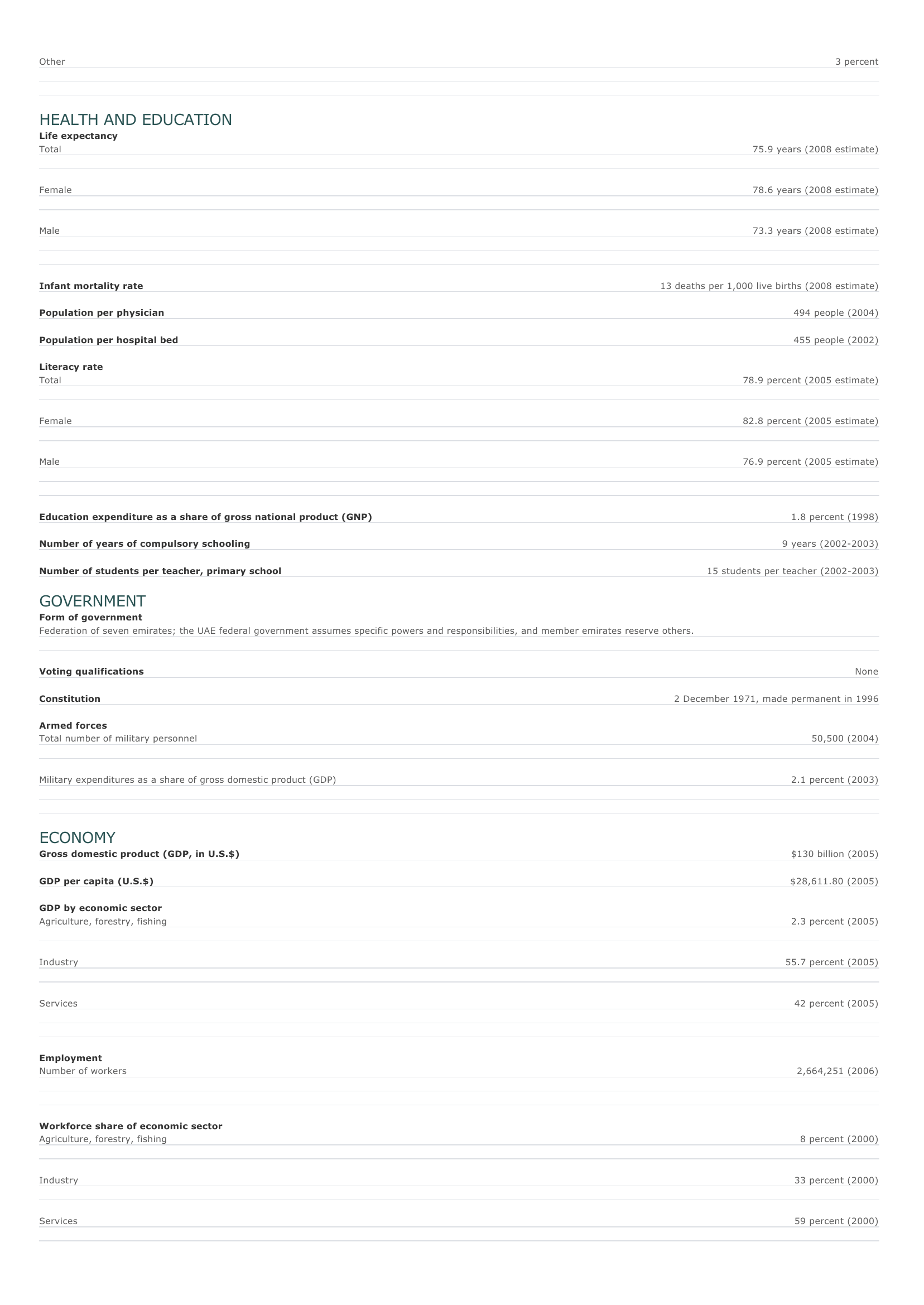United Arab Emirates Facts and Figures. BASIC FACTS Official name Capital Area United Arab Emirates Abu Dhabi 83,600 sq km 32,300 sq mi PEOPLE Population 4,621,399 (2008 estimate) Population growth Population growth rate 3.83 percent (2008 estimate) Projected population in 2025 7,063,346 (2025 estimate) Projected population in 2050 8,018,904 (2050 estimate) Population density 55 persons per sq km (2008 estimate) 143 persons per sq mi (2008 estimate) Urban/rural distribution Share urban 86 percent (2005 estimate) Share rural 15 percent (2005 estimate) Largest cities, with population Dubai 1,321,453 (2006) Abu Dhabi 475,000 (2003 estimate) Ash Sh? riqah 488,000 (2002 estimate) Al Ain 328,000 (2002 estimate) 'Ajm? n 205,000 (2002 estimate) Ethnic groups UAE Arab 19 percent Other Arab 23 percent South Asian (largely Indians, Pakistanis, Sri Lankans, Bangladeshis) 50 percent Other expatriates (includes Westerners and East Asians) 8 percent NOTE: Roughly 25 percent are UAE citizens. Languages Arabic (official), Persian (Farsi), English, Hindi, Urdu Religious affiliations Islam (mostly Sunni Muslim) 76 percent Christian 11 percent Hindu 8 percent Baha'i 2 percent O ther 3 percent HEALTH AND EDUCATION Life expectancy Total 75.9 years (2008 estimate) Female 78.6 years (2008 estimate) Male 73.3 years (2008 estimate) Infant mortality rate 13 deaths per 1,000 live births (2008 estimate) Population per physician 494 people (2004) Population per hospital bed 455 people (2002) Literacy rate Total 78.9 percent (2005 estimate) Female 82.8 percent (2005 estimate) Male 76.9 percent (2005 estimate) Education expenditure as a share of gross national product (GNP) 1.8 percent (1998) Number of years of compulsory schooling 9 years (2002-2003) Number of students per teacher, primary school 15 students per teacher (2002-2003) GOVERNMENT Form of government Federation of seven emirates; the UAE federal government assumes specific powers and responsibilities, and member emirates reserve others. Voting qualifications Constitution Armed forces Total number of military personnel Military expenditures as a share of gross domestic product (GDP) None 2 December 1971, made permanent in 1996 50,500 (2004) 2.1 percent (2003) ECONOMY Gross domestic product (GDP, in U.S.$) $130 billion (2005) GDP per capita (U.S.$) $28,611.80 (2005) GDP by economic sector Agriculture, forestry, fishing 2.3 percent (2005) I ndustry 55.7 percent (2005) Services 42 percent (2005) Employment Number of workers 2,664,251 (2006) Workforce share of economic sector Agriculture, forestry, fishing 8 percent (2000) I ndustry 33 percent (2000) Services 59 percent (2000) Unemployment rate 2.3 percent (2000) National budget (U.S.$) Total revenue $5,236 million (1999) Total expenditure $5,505 million (1999) Monetary unit 1 UAE dirham (Dh), consisting of 100 fils Major trade partners for exports Japan, South Korea, Oman, Thailand, and Iran Major trade partners for imports Japan, United States, Germany, China, and United Kingdom ENERGY, COMMUNICATIONS, AND TRANSPORTATION Electricity production Electricity from thermal sources 100 percent (2003 estimate) Electricity from hydroelectric sources 0 percent (2003 estimate) Electricity from nuclear sources 0 percent (2003 estimate) Electricity from geothermal, solar, and wind sources 0 percent (2003 estimate) Number of radios per 1,000 people 355 (1997) Number of telephones per 1,000 people 273 (2005) Number of televisions per 1,000 people 318 (2000 estimate) Number of Internet hosts per 10,000 people 139 (2003) Daily newspaper circulation per 1,000 people 170 (1996) Number of motor vehicles per 1,000 people 103 (1997) Paved road as a share of total roads 100 percent (1999) SOURCES Basic Facts and People sections Area data are from the statistical bureaus of individual countries. Population, population growth rate, and population projections are from the United States Census Bureau, International Programs Center, International Data Base (IDB) (www.census.gov). Urban and rural population data are from the Food and Agriculture Organization (FAO) of the United Nations (UN), FAOSTAT database (www.fao.org). Largest cities population data and political divisions data are from the statistical bureaus of individual countries. Ethnic divisions and religion data are largely from the latest Central Intelligence Agency (CIA) World Factbook and from various country censuses and reports. Language data are largely from the Ethnologue, Languages of the World, Summer Institute of Linguistics International (www.sil.org). Health and Education section Life expectancy and infant mortality data are from the United States Census Bureau, International Programs Center, International database (IDB) (www.census.gov). Population per physician and population per hospital bed data are from the World Health Organization (WHO) (www.who.int). Education data are from the United Nations Educational, Scientific and Cultural Organization (UNESCO) database (www.unesco.org). Government section Government, independence, legislature, constitution, highest court, and voting qualifications data are largely from various government Web sites, the latest Europa World Yearbook, and the latest Central Intelligence Agency (CIA) World Factbook. The armed forces data is from Military Balance. Economy section Gross domestic product (GDP), GDP per capita, GDP by economic sectors, employment, and national budget data are from the World Bank database (www.worldbank.org). Monetary unit, agriculture, mining, manufacturing, exports, imports, and major trade partner information is from the statistical bureaus of individual countries, latest Europa World Yearbook, and various United Nations and International Monetary Fund (IMF) publications. Energy, Communication, and Transportation section Electricity information is from the Energy Information Administration (EIA) database (www.eia.doe.gov). Radio, telephone, television, and newspaper information is from the United Nations Educational, Scientific and Cultural Organization (UNESCO) database (www.unesco.org). Internet hosts, motor vehicles, and road data are from the World Bank database (www.worldbank.org). Note Figures may not total 100 percent due to rounding. Microsoft ® Encarta ® 2009. © 1993-2008 Microsoft Corporation. All rights reserved.






